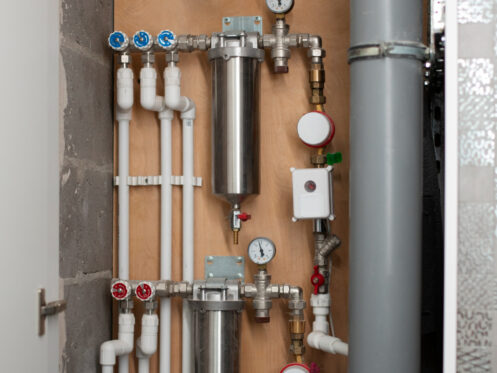Low-flow fixture installation is one of the most effective ways to reduce water use at home, without sacrificing comfort or performance.
These water-saving devices include toilets, showerheads, and faucets designed to use significantly less water than conventional models while maintaining good performance.
Switching to low-flow fixtures can reduce your water usage by 30-50% without sacrificing comfort or convenience.The technology has improved dramatically in recent years, addressing earlier complaints about weak water pressure or poor flushing power.
Modern low-flow toilets use innovative designs like pressure-assist systems, while efficient showerheads maintain strong spray patterns despite using less water.
We often see homeowners hesitant to make the switch because of concerns about cost or performance. However, the initial investment typically pays for itself through lower water bills within a year or two.
Plus, summer is the perfect time to make these upgrades while water usage tends to increase due to gardening, more frequent showers, and other seasonal activities.
In this guide, you’ll learn how low-flow fixtures work, the benefits they offer for your household and the environment, and what to consider before making the switch.
Here’s what you need to know:
- Understanding low-flow fixtures
- Benefits of switching to low-flow fixtures
- Planning your low-flow fixture upgrade this summer
Whether you’re looking to save money, use resources more wisely, or improve your plumbing efficiency, this summer is an ideal time to take action.
Understanding low-flow fixtures
Low-flow fixtures are designed to use less water while maintainingfunctionality. These water-saving devices come in various forms and work through innovative technology that reduces consumption without sacrificing performance.
Common types of low-flow fixtures and how they work
Low-flow toilets use 1.28 gallons per flush or less, compared to older models that used 3.5 to 7 gallons. These efficient toilets use gravity, pressure-assisted, or dual-flush technology to remove waste effectively with minimal water.
Faucet aerators are simple devices that screw onto faucet heads, mixing air with water to maintain pressure while reducing flow. Standard faucets use 2.2 gallons per minute (GPM), while low-flow versions use 1.5 GPM or less.
Low-flow showerheads reduce water use from the standard 2.5 GPM to 1.5-2.0 GPM. Many models feature adjustable settings for different spray patterns and pressure levels.
Other low-flow fixtures include water-efficient dishwashers, washing machines, and urinals. Many carry the WaterSense label, indicating they meet EPA efficiency standards.
How low-flow technology works
Low-flow fixtures use several clever engineering approaches to reduce water consumption. Aerators mix air with water to maintain perceived pressure and flow while using less actual water. This creates a steady, splash-free stream that feels substantial.
Pressure-compensating technology maintains consistent water delivery regardless of home water pressure variations. This ensures performance remains reliable even with reduced volume.
Some fixtures use precision spray patterns that focus water more effectively. By directing water exactly where needed, these designs clean effectively with less volume.
Many modern low-flow fixtures incorporate smart sensors or timers that automatically shut off water flow after a certain period or when not in use.
Key differences from standard fixtures
The most obvious difference is water consumption. Low-flow fixtures typically use 30-50% less water than standard fixtures, which translates to significant utility bill savings.
Despite using less water, quality low-flow fixtures maintain sufficient water pressure through smart design. This is a major improvement over early models that often resulted in multiple flushes or longer shower times.
Installation requirements are generally the same as standard fixtures. Most low-flow options are designed as direct replacements, making the switch relatively simple for most homeowners.
The initial cost of low-flow fixtures is often slightly higher than standard options. However, the water savings typically recover this difference within 1-3 years, making them cost-effective long-term investments.
Benefits of switching to low-flow fixtures
Making the switch to low-flow fixtures offers multiple advantages that impact both your household and the wider environment. These water-efficient alternatives can transform your home’s resource usage while providing tangible benefits.
Water conservation and environmental impact
Low-flow fixtures significantly reduce water consumption in your home. A standard toilet uses about 3.5 gallons per flush, while low-flow models use just 1.28 gallons or less. This represents a 60-70% reduction in water usage.
Shower heads show similar improvements. Traditional models use 5-8 gallons per minute, while low-flow versions use only 1.5-2.5 gallons. Over a year, this can save thousands of gallons of water per fixture.
According to the EPA, replacing older toilets with WaterSense-labeled models can save the average family up to 13,000 gallons of water and $140 in utility costs annually. These savings highlight the long-term value of upgrading even a single fixture.
The environmental benefits extend beyond your home. When we reduce water consumption, we help preserve local water supplies and reduce strain on water treatment facilities.
Water conservation becomes increasingly important as many regions face drought conditions and water scarcity. By installing low-flow fixtures, we contribute to community-wide conservation efforts.
How low-flow fixtures can cut your water bills
The financial benefits of low-flow fixtures are substantial and begin immediately after installation. Most households see a noticeable decrease in their monthly water bills.
Average Annual Savings:
- Low-flow toilet: $110 per year
- Low-flow shower head: $70-$80 per year
- Low-flow faucet: $30-$50 per year
The return on investment is impressive, with most fixtures paying for themselves in less than 3 years. Many water utilities also offer rebates when you upgrade to water-efficient fixtures, further reducing your costs.
For a family of four, total water bill savings can reach $300-$400 annually. These savings continue year after year, making low-flow fixtures a smart long-term investment.
Energy and infrastructure benefits of low-flow plumbing
Low-flow fixtures don’t just save water—they save energy too. When we use less hot water for showers and handwashing, we reduce the energy needed to heat that water.
This energy reduction can lead to lower electricity or gas bills, adding to your overall savings. A typical household can save 10-15% on water heating costs by installing low-flow fixtures throughout the home.
From an infrastructure perspective, reduced water usage means less strain on municipal water systems. Water treatment facilities require significant energy to purify and pump water to homes.
When communities adopt low-flow fixtures widely, the decreased demand can postpone costly infrastructure expansions. This benefits everyone through stable water rates and reduced environmental impact.
Saving money during inflation with water-efficient upgrades
During periods of inflation, every opportunity to reduce monthly expenses matters. Water and energy bills are ongoing costs that can be meaningfully reduced with low-flow fixtures.
Installing these fixtures provides immediate relief from rising utility costs. While grocery and fuel prices fluctuate with market conditions, the savings from efficient fixtures remain consistent.
We can view low-flow fixtures as a hedge against future rate increases. Many municipalities are implementing tiered pricing structures that charge more for higher water usage. Low-flow fixtures keep you in lower pricing tiers.
For homeowners on fixed incomes, these savings can be especially valuable. The investment in water-efficient fixtures creates predictable, long-term financial benefits during uncertain economic times.
Planning your low-flow fixture upgrade this summer
Summer is the perfect time to upgrade your fixtures to more efficient options. Warmer months often bring higher water bills, making this season ideal for investments that can deliver long-term savings.
Assessing compatibility with your plumbing
Before purchasing low-flow fixtures, we recommend checking your home’s plumbing system. Older homes with pipes installed before 1990 may have plumbing that’s not optimized for low-flow technology.
Look at your current water pressure readings. If your home already experiences low pressure, consult with a plumberbefore making changes. Some buildings require minimum flow rates to function properly.
Check your pipe diameter and material too. Narrower pipes or those with mineral buildup might not work well with certain low-flow fixtures.
It’s also worth examining your water heater’scapacity. Low-flow fixtures can sometimes affect how quickly hot water reaches your faucet or shower.
Choosing certified watersense products
WaterSense-labeled products are your best option when selecting low-flow fixtures. These products have been independently certified to use at least 20% less water while performing as well as standard fixtures.
Look for the blue WaterSense label on:
- Toilets (using 1.28 gallons per flush or less)
- Bathroom faucets (1.5 gallons per minute or less)
- Showerheads (2.0 gallons per minute or less)
Price comparison:While WaterSense products might cost slightly more upfront, they typically save enough water to pay for themselves within 1-2 years.
Many utilities offer rebates for WaterSense fixtures, making summer an excellent time to check local incentive programs. These rebates can significantly reduce your initial investment.
Extra ways to boost your home’s water efficiency
Pair your new low-flow fixtures with other water-saving practices for maximum benefit. Install aerators on existing faucets as an inexpensive first step if complete replacement isn’t in your budget yet.
Consider upgrading to energy-efficient appliances alongside your low-flow fixtures. ENERGY STARdishwashers and washing machines use significantly less water than older models.
Smart home integration:Some newer low-flow fixtures work with programmable thermostats and home automation systems to optimize both water and energy use.
LED light bulbs in bathrooms and kitchens complement your water-saving efforts by reducing overall utility costs. This creates a more comprehensive approach to conservation.
Don’t forget outdoor water use! Summer is the perfect time to install water-efficient irrigation systems or rain barrels to capture natural precipitation.
Wrapping Up: Key Insights and TakeawaysConclusion
Switching to low-flow fixtures is a practical upgrade that delivers measurable benefits across your home. From reducing water and energy usage to lowering monthly utility bills, these efficient systems support both household savings and broader environmental goals.
With options like WaterSense-labeled toilets, showerheads, and faucets, you can make a noticeable impact without compromising performance.
As summer drives up water usage, now is the perfect time to act. Whether you’re upgrading for cost savings or conservation, a professional low-flow fixture installation ensures compatibility and long-term results.
Contact Splash Plumbingto get expert advice and efficient installation tailored to your home’s plumbing system.












